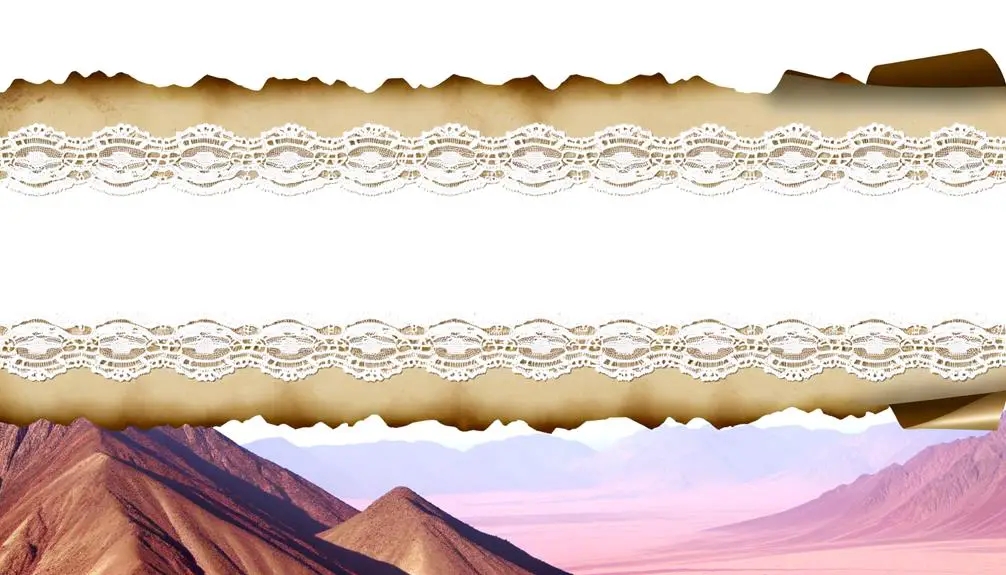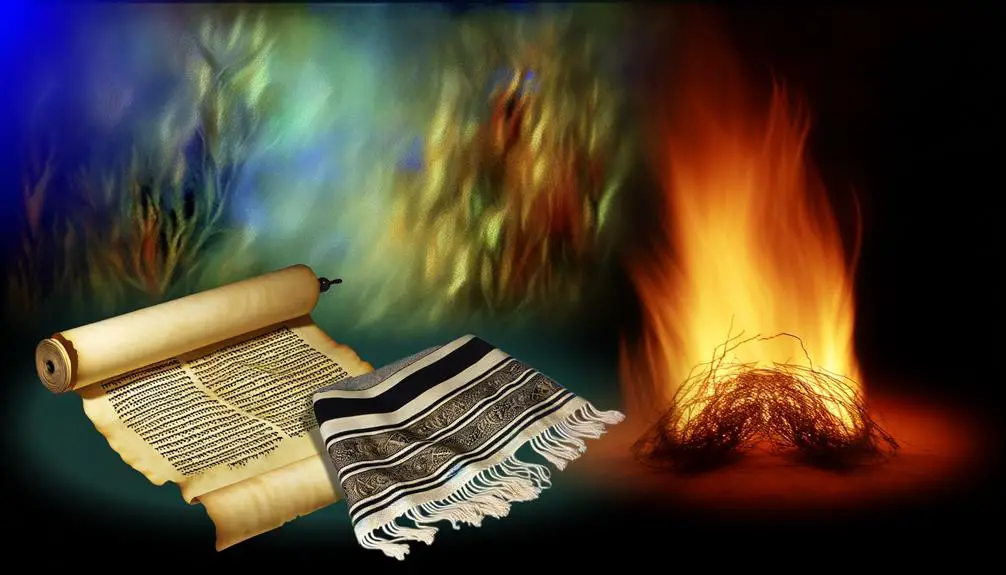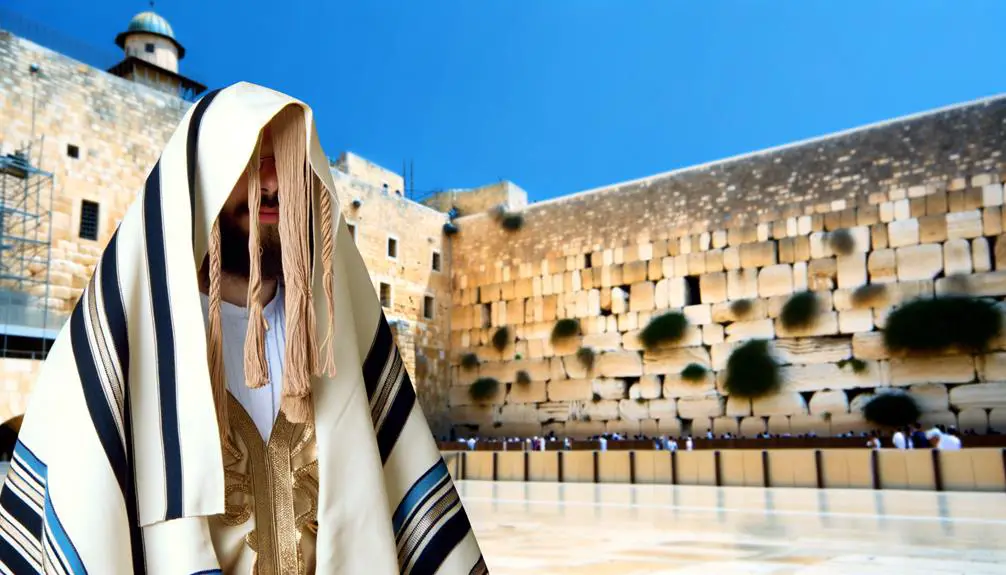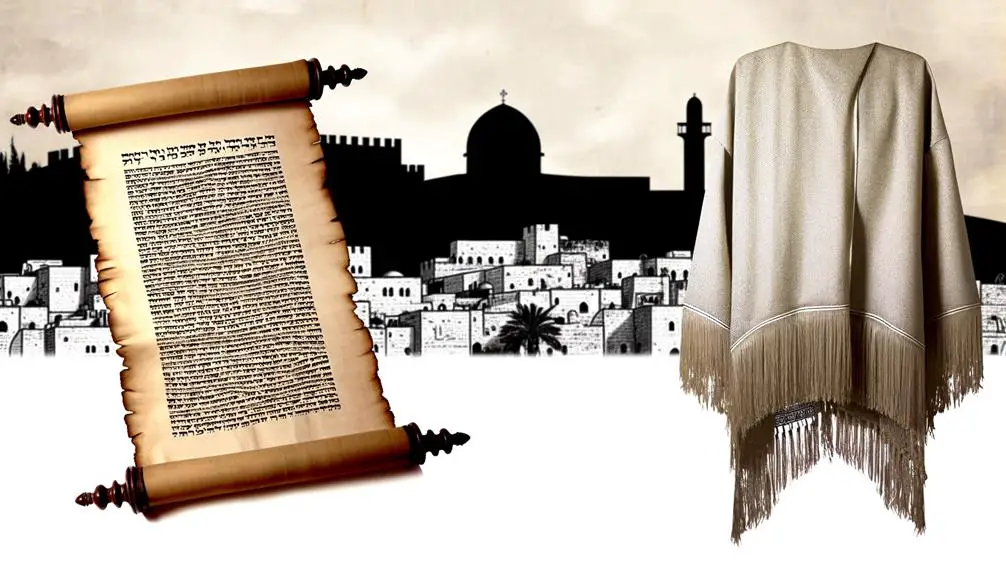Highlighting profound symbolism, fringes in the Bible weave together faith's past and present, inviting a closer look at this intricate spiritual thread.

Fringes in the Bible
As you walk through the tapestry of biblical teachings, you'll find the concept of fringes not just dangling on the edges but woven into the very fabric of spiritual and cultural identity. These aren't mere threads on garments but carry profound symbolic meanings, reminders of commandments, and a bridge between past traditions and present practices.
Exploring fringes offers a unique lens to view the continuum of faith from ancient Israel through to modern interpretations in both Jewish and Christian contexts. There's much to uncover about how this seemingly small detail encapsulates significant aspects of belief, community, and personal conduct, inviting you to look closer at the threads that connect the past with the present.
Key Takeaways
- Fringes, or tzitzit, originate from ancient biblical commandments, serving as physical reminders of divine mandates.
- Their materials, colors, and styles symbolize purity, spiritual concepts, and individual and communal identity.
- In Jewish tradition, fringes are worn to integrate spiritual obligations into daily life, reflecting adherence and adaptation over time.
- In Christianity, fringes symbolize a broader spiritual commitment, with interpretations varying among denominations.
The Origin of Fringes

The concept of fringes, deeply rooted in ancient biblical traditions, originates from specific commandments found in the Torah, instructing the Israelites to attach these decorative yet symbolic tassels to the corners of their garments. You'll find that the materials and styles used for these fringes have varied widely over time, reflecting an array of cultural interpretations and adaptations. Initially, the fringes, or tzitzit as they're referred to in Hebrew, were likely made from the same material as the garment itself, typically wool or linen. Over time, the selection of fringe materials expanded, incorporating dyed threads and even gold strands, to signify status or adherence to specific religious sects.
Cultural variations in the styling and incorporation of fringes further illustrate the dynamic nature of this practice. For instance, in some Jewish communities, the fringes are long and prominently displayed, while in others, they're more discreet. This variation isn't merely aesthetic but carries deep cultural significance, reflecting varying interpretations of modesty, identity, and tradition. Additionally, the methods of knotting and weaving the fringes have developed unique symbolic meanings across different communities, turning each set of tzitzit into a nuanced, deeply personal expression of faith and heritage.
Analyzing these variations, you're observing not just a simple commandment from ancient texts but a living, evolving tradition. The choice of fringe materials and the cultural variations in their display encapsulate a rich tapestry of history, identity, and spirituality that continues to evolve with each generation.
Symbolic Meanings

Delving into the symbolic meanings of fringes, you'll find that each knot and twist carries a profound spiritual significance, reflecting an intricate web of religious commandments and ethical teachings. The colors of the fringes and their patterns aren't simply aesthetic choices; they're imbued with deep symbolic meanings, varying widely across different cultures and historical periods.
Symbol |
Cultural Influence |
Meaning |
|---|---|---|
Blue |
Ancient Israel |
Remembrance of God's commandments |
White |
General |
Purity and spiritual enlightenment |
Red |
Some Christian interpretations |
Sacrifice and redemption |
Purple |
Royal contexts |
Sovereignty and divine kingdom |
Fringe colors, in particular, play a pivotal role in their symbolism. Blue, often mentioned in biblical texts, is traditionally associated with the heavens and divine command, urging the wearer to remember and adhere to God's laws. White fringes, found across many cultures, symbolize purity and connection to the divine, representing a follower's aspiration towards spiritual cleanliness and enlightenment.
Cultural influences are also significant in understanding the symbolic meanings of fringes. For instance, red, though less commonly associated with biblical fringes, has been interpreted in some Christian contexts to symbolize the sacrifice and redemption offered through Jesus Christ. Purple fringes, on the other hand, are often linked to royalty and sovereignty, suggesting a connection to the divine kingdom.
The detailed symbolism woven into the fabric of these fringes underscores their role not just as physical adornments but as potent reminders of spiritual commitments and ethical principles. Through their colors and configurations, fringes serve as a tactile and visual representation of a believer's ongoing journey towards spiritual fulfillment and moral integrity.
Commandment and Remembrance

You'll find that tassels, or fringes, serve not just as ornamental additions but as physical embodiments of commandments within the biblical text.
These elements function as tactile reminders for adherents to uphold specific mandates, intertwining daily life with spiritual obligations.
This interplay between material culture and memory underscores the profound role of fringes in fostering a continuous consciousness of one's duties and beliefs.
Tassels as Commandments
In biblical tradition, tassels serve as a physical embodiment of God's commandments, reminding adherents to live in accordance with divine law. These tassels, tied to the corners of garments, aren't merely decorative. They're laden with meaning, each thread and knot symbolizing aspects of faith and obedience. The material choices and the method of crafting these tassels speak volumes about their significance.
Aspect |
Description |
|---|---|
Fringe Benefits |
Symbolizes adherence and spiritual commitment |
Material Choices |
Reflects devotion through specific fabrics |
Purpose |
Serves as a constant reminder of God's laws |
Design |
Encodes messages and values |
Placement |
Attached to garments, ensuring visibility |
This practice intertwines the physical with the spiritual, making everyday garments a testament to faith.
Fringes for Memory
Building on the understanding that tassels symbolize adherence and spiritual commitment, it's crucial to explore how they also serve as mnemonic devices, anchoring the commandments in the memory of those who wear them. The use of fringes as memory aids showcases a fascinating intersection of faith and cognitive psychology.
- Fringes remind wearers of their spiritual and ethical obligations.
- They act as physical touchpoints for recollection and reflection.
- Memory aids like these bridge cultural adaptation, allowing traditions to persist in changing environments.
- The visual and tactile nature of fringes supports memory retention.
- Their presence reinforces community identity and collective memory.
This detailed examination reveals how cultural adaptation and the use of tangible objects like fringes can enhance the practice of remembrance within a faith community.
Fringes in Jewish Tradition

You'll find that the symbolism of fringes in Jewish tradition encapsulates a rich tapestry of meaning, spanning from reminders of divine commandments to markers of identity. Historical fringe practices reveal a nuanced evolution, shaped by rabbinic interpretations and regional customs, which have significantly influenced how these traditions are observed today.
Moreover, the variations in modern observance reflect a spectrum of adherence and adaptation, highlighting the dynamic interplay between ancient texts and contemporary Jewish life.
Symbolism of Fringes
Through examining the symbolism of fringes in Jewish tradition, one discovers that these elements serve as a tangible reminder of the commandments and the covenant between God and the people of Israel. The significance of these fringes isn't merely aesthetic; rather, they encapsulate deep spiritual meanings and intentions:
- Fringe materials: Traditionally, wool or cotton, signifying purity and dedication.
- Fringe colors: Often include blue, representing the divine and the infinite.
*Serves as a constant reminder of one's duties to God and community.*
*Emphasizes the importance of remembering and observing the commandments.*
*Symbolizes the intertwining of the divine with daily life, urging adherence to spiritual principles.*
These fringes aren't just decorative; they're imbued with profound religious significance, guiding the wearer in their spiritual journey.
Historical Fringe Practices
Delving into the historical practices of fringes in Jewish tradition reveals a multifaceted approach to spiritual observance, deeply rooted in ancient texts and rituals. Fringe materials initially comprised wool or linen, signifying a direct link to scriptural mandates. These materials weren't chosen at random; they embodied purity laws and social status.
Over centuries, cultural adaptations introduced variations in colors and patterns, reflecting the evolving Jewish diaspora's identities. Yet, the core symbolism and intention—remembrance of the commandments and reinforcement of a Jewish identity—remained steadfast.
Analyzing these practices, one discerns a meticulous balance between adherence to biblical injunctions and the adaptability to encompass diverse Jewish experiences, illustrating a dynamic interplay between tradition and cultural influence in the realm of religious observance.
Modern Observance Variations
In contemporary Jewish practice, variations in the observance of fringes exhibit a rich tapestry of tradition and individual expression, reflecting both adherence to ancient commandments and the nuances of modern identity. This dynamic interplay manifests in several key areas:
- Fashion integration: Fringes are subtly incorporated into everyday wear, balancing commandment observance with contemporary fashion.
- Cultural adaptation: The style and visibility of fringes adjust across diverse Jewish communities, mirroring broader cultural influences.
- Material selection: Innovations in textile technology influence the choice of materials for fringes, enhancing durability and comfort.
- Color variations: While traditional white remains prevalent, the inclusion of blue threads reflects a resurgence in ancient practices, interpreted through modern lenses.
- Customization: Personal preferences shape the length, thickness, and tie patterns of fringes, underscoring individual identity within communal tradition.
Fringes and Christian Interpretation

While interpretations of biblical fringes have evolved, Christians often view them as symbols of faithfulness and divine command. The concept of fringes, originating from Old Testament directives, specifically in the book of Numbers, has spurred various fringe controversies among Christian denominations. These fringes were initially commanded by God as a physical reminder for the Israelites to obey His commandments. However, in the Christian context, the physical wearing of fringes has taken a backseat to the metaphorical interpretation.
Contemporary interpretations among Christians suggest that fringes symbolize a broader spiritual commitment rather than a strict adherence to wearing specific garments. This shift reflects an understanding that the essence of God's command is more about internalizing His word and living it out in daily actions, rather than the literal wearing of fringes. This perspective has been shaped by New Testament teachings, where Jesus Christ emphasizes the importance of inner faithfulness over external religious practices.
Despite this, fringe controversies persist, especially when considering the diverse practices across different Christian communities. Some groups advocate for a more literal interpretation and incorporation of Old Testament practices, including the wearing of fringes, into their faith life. Others argue that the New Testament supersedes Old Testament rituals, thus de-emphasizing their importance.
The debate highlights the dynamic nature of religious interpretation and the challenge of applying ancient texts to contemporary faith practices. Ultimately, the discussion around Biblical fringes among Christians serves as a microcosm of the broader dialogue on how to faithfully live out biblical principles in a modern context.
Historical Significance

Understanding the historical significance of biblical fringes requires examining their origins and the societal context in which they were first introduced. These fringes, known as tzitzit in Hebrew, weren't merely decorative. They held profound religious and cultural significance, emblematic of identity, faith, and divine commandments. As you delve into their history, you'll see how they reflected the textile evolution of ancient societies and were shaped by various cultural influences.
To grasp their multifaceted role, consider these aspects:
- Cultural influences: Fringes served as a physical reminder of the wearer's covenant with God, but they also mirrored the broader cultural practices of neighboring civilizations. The adoption and adaptation of fringes highlight the interplay between Israelite identity and the surrounding pagan cultures.
- Textile evolution: The materials and methods used in creating fringes evolved, reflecting advancements in textile technology. Initially, fringes might've been simple, twisted cords, but over time, they became more elaborate, incorporating dyed threads such as the prestigious tekhelet.
- Societal norms: Fringes were a visual cue of societal norms and religious adherence. They distinguished the Israelites from other groups, reinforcing community cohesion and identity.
- Legal implications: The commandment to wear fringes was taken very seriously, with detailed laws governing their construction and use. This illustrates the legalistic aspect of ancient Israelite society.
- Symbolic meanings: Beyond their physical appearance, fringes symbolized themes of memory, obedience, and spirituality. They reminded wearers of their duties to God and their community, serving as a tangible link to their spiritual obligations.
Analyzing the historical significance of biblical fringes offers insights into ancient Israelite society, their religious practices, and how these elements were influenced by and reflected in the broader ancient Near Eastern context.
Modern Relevance and Practice

Today's practices surrounding biblical fringes, or tzitzit, reveal their enduring relevance in contemporary religious life, reflecting a deep-seated tradition that bridges ancient commandments with modern identity. You'll find that fashion influence and cultural adaptation play crucial roles in how tzitzit are embraced and exhibited in the daily lives of those who observe this commandment.
The integration of tzitzit into modern attire is a fascinating study in cultural adaptation. As societies evolve, so too does the expression of religious observance. You often see tzitzit attached to garments that blend seamlessly with contemporary fashion, ensuring adherence to religious mandates while engaging with modern aesthetic sensibilities. This adaptation demonstrates a dynamic relationship between tradition and innovation, where ancient practices aren't merely preserved but are actively interpreted and integrated into the fabric of current lifestyles.
Fashion influence is equally significant in the evolution of tzitzit's presentation. Designers within religious communities have reimagined these fringes in ways that respect their biblical origins while appealing to current trends. This has led to a variety of styles and methods of wearing tzitzit, making them accessible and attractive to a broader audience. It's a clear indication that religious practice and personal expression can coexist, enriching one another.
Ultimately, the modern relevance and practice of wearing tzitzit underscore a commitment to faith that transcends time. They serve as a tangible link to a storied past, while their cultural adaptation and fashion influence ensure they remain a vibrant and meaningful part of today's religious identity.
Frequently Asked Questions
How Do Fringes in the Bible Relate to Contemporary Fashion Trends and Their Appropriation?
You're exploring how historical elements like fringes influence today's fashion cycles, often leading to debates on cultural appropriation.
It's fascinating to see these ancient styles resurface, yet it's crucial to navigate the thin line between inspiration and appropriation.
Understanding the origins and significance can foster appreciation without disrespect.
Your analysis digs into why certain trends reemerge and the importance of respecting cultural heritage in fashion's ever-evolving landscape.
Are There Any Notable Artworks or Literary Works That Feature Biblical Fringes, and What Interpretations Do They Offer?
You're exploring how fringe symbolism is depicted in notable artworks and literary pieces, delving into the interpretations they offer. Artistic representation of fringes often carries profound meanings, reflecting societal, cultural, or spiritual themes.
How Have Different Cultures Outside the Jewish and Christian Traditions Integrated or Interpreted the Concept of Fringes From the Bible in Their Own Spiritual or Social Practices?
You're diving into a tapestry of traditions where cultural assimilation weaves its threads through spiritual symbolism. Various cultures have embroidered the concept of fringes, originally from biblical texts, into their own spiritual or social fabrics.
This intricate interlacing showcases how interpretations and integrations of fringes vary widely, from sacred adornments to symbols of identity or protection. Each stitch reflects a unique blend of reverence and adaptation, illustrating a rich, multi-cultural dialogue.
What Are the Environmental Impacts of Producing Traditional Fringes as Described in the Bible, Considering Modern Materials and Methods?
When you examine the environmental impacts of producing traditional fringes with modern materials and methods, it's clear there are significant effects. Material sustainability becomes a pressing concern as the demand for these items increases.
Fringe recycling presents a viable solution, reducing waste and promoting a circular economy. By focusing on eco-friendly materials and recycling efforts, you can significantly mitigate the environmental footprint associated with producing these traditional adornments.
Has the Concept of Fringes From the Bible Been Utilized in Any Significant Political or Social Movements for Symbolism, and if So, How and Why?
You've stumbled upon a patchwork of history where fringe politics weaves its threads through social movements. This symbolic adoption of fringes isn't just about fabric; it's a deliberate choice to embody values and messages deeply rooted in tradition.
Conclusion
In conclusion, the significance of fringes in biblical texts isn't just a minor detail; it's a colossal landmark in religious symbolism. These threads, more than mere fabric, are a divine GPS, guiding the faithful through a spiritual desert.
They're not just reminders of commandments; they're celestial whispers woven into the very fabric of existence. In both Jewish and Christian traditions, fringes are a testament to a faith that's as vibrant and enduring as the universe itself.
Their relevance today? Undiminished, echoing eternity.



Sign up